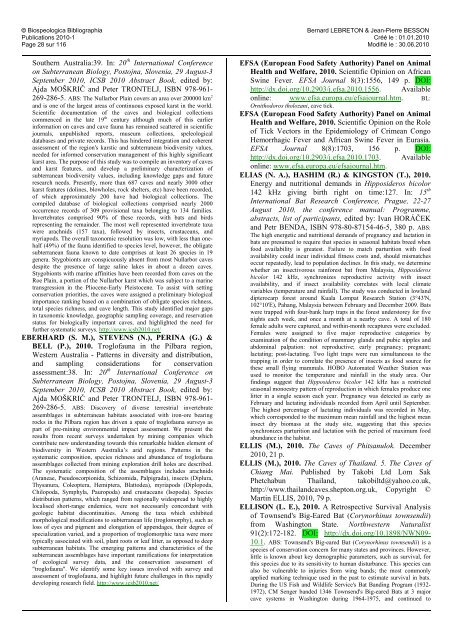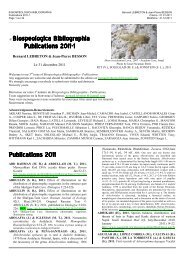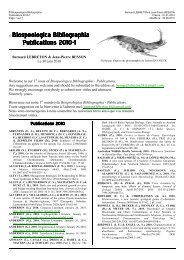Biospeologica Bibliographia Publications 2010-2
Biospeologica Bibliographia Publications 2010-2
Biospeologica Bibliographia Publications 2010-2
Create successful ePaper yourself
Turn your PDF publications into a flip-book with our unique Google optimized e-Paper software.
© <strong>Biospeologica</strong> <strong>Bibliographia</strong><br />
<strong>Publications</strong> <strong>2010</strong>-1<br />
Page 28 sur 116<br />
Southern Australia:39. In: 20 th International Conference<br />
on Subterranean Biology, Postojna, Slovenia, 29 August-3<br />
September <strong>2010</strong>, ICSB <strong>2010</strong> Abstract Book, edited by:<br />
Ajda MOŠKRIČ and Peter TRONTELJ, ISBN 978-961-<br />
269-286-5. ABS: The Nullarbor Plain covers an area over 200000 km 2<br />
and is one of the largest areas of continuous exposed karst in the world.<br />
Scientific documentation of the caves and biological collections<br />
commenced in the late 19 th century although much of this earlier<br />
information on caves and cave fauna has remained scattered in scientific<br />
journals, unpublished reports, museum collections, speleological<br />
databases and private records. This has hindered integration and coherent<br />
assessment of the region's karstic and subterranean biodiversity values,<br />
needed for informed conservation management of this highly significant<br />
karst area. The purpose of this study was to compile an inventory of caves<br />
and karst features, and develop a preliminary characterization of<br />
subterranean biodiversity values, including knowledge gaps and future<br />
research needs. Presently, more than 687 caves and nearly 3000 other<br />
karst features (dolines, blowholes, rock shelters, etc) have been recorded,<br />
of which approximately 200 have had biological collections. The<br />
compiled database of biological collections comprised nearly 2000<br />
occurrence records of 309 provisional taxa belonging to 134 families.<br />
Invertebrates comprised 90% of these records, with bats and birds<br />
representing the remainder. The most well represented invertebrate taxa<br />
were arachnids (157 taxa), followed by insects, crustaceans, and<br />
myriapods. The overall taxonomic resolution was low, with less than onehalf<br />
(49%) of the fauna identified to species level, however, the obligate<br />
subterranean fauna known to date comprises at least 26 species in 19<br />
genera. Stygobionts are conspicuously absent from most Nullarbor caves<br />
despite the presence of large saline lakes in about a dozen caves.<br />
Stygobionts with marine affinities have been recorded from caves on the<br />
Roe Plain, a portion of the Nullarbor karst which was subject to a marine<br />
transgression in the Pliocene-Early Pleistocene. To assist with setting<br />
conservation priorities, the caves were assigned a preliminary biological<br />
importance ranking based on a combination of obligate species richness,<br />
total species richness, and cave length. This study identified major gaps<br />
in taxonomic knowledge, geographic sampling coverage, and reservation<br />
status for biologically important caves, and highlighted the need for<br />
further systematic surveys. http://www.icsb<strong>2010</strong>.net/<br />
EBERHARD (S. M.), STEVENS (N.), PERINA (G.) &<br />
BELL (P.), <strong>2010</strong>. Troglofauna in the Pilbara region,<br />
Western Australia - Patterns in diversity and distribution,<br />
and sampling considerations for conservation<br />
assessment:38. In: 20 th International Conference on<br />
Subterranean Biology, Postojna, Slovenia, 29 August-3<br />
September <strong>2010</strong>, ICSB <strong>2010</strong> Abstract Book, edited by:<br />
Ajda MOŠKRIČ and Peter TRONTELJ, ISBN 978-961-<br />
269-286-5. ABS: Discovery of diverse terrestrial invertebrate<br />
assemblages in subterranean habitats associated with iron-ore bearing<br />
rocks in the Pilbara region has driven a spate of troglofauna surveys as<br />
part of pre-mining environmental impact assessment. We present the<br />
results from recent surveys undertaken by mining companies which<br />
contribute new understanding towards this remarkable hidden element of<br />
biodiversity in Western Australia’s arid regions. Patterns in the<br />
systematic composition, species richness and abundance of troglofauna<br />
assemblages collected from mining exploration drill holes are described.<br />
The systematic composition of the assemblages includes arachnids<br />
(Araneae, Pseudoscorpionida, Schizomida, Palpigrada), insects (Diplura,<br />
Thysanura, Coleoptera, Hemiptera, Blattodea), myriapods (Diplopoda,<br />
Chilopoda, Symphyla, Pauropoda) and crustaceans (Isopoda). Species<br />
distribution patterns, which ranged from regionally widespread to highly<br />
localised short-range endemics, were not necessarily concordant with<br />
geologic habitat discontinuities. Among the taxa which exhibited<br />
morphological modifications to subterranean life (troglomorphy), such as<br />
loss of eyes and pigment and elongation of appendages, their degree of<br />
specialization varied, and a proportion of troglomorphic taxa were more<br />
typically associated with soil, plant roots or leaf litter, as opposed to deep<br />
subterranean habitats. The emerging patterns and characteristics of the<br />
subterranean assemblages have important ramifications for interpretation<br />
of ecological survey data, and the conservation assessment of<br />
"troglofauna". We identify some key issues involved with survey and<br />
assessment of troglofauna, and highlight future challenges in this rapidly<br />
developing research field. http://www.icsb<strong>2010</strong>.net/<br />
Bernard LEBRETON & Jean-Pierre BESSON<br />
Créé le : 01.01.<strong>2010</strong><br />
Modifié le : 30.06.<strong>2010</strong><br />
EFSA (European Food Safety Authority) Panel on Animal<br />
Health and Welfare, <strong>2010</strong>. Scientific Opinion on African<br />
Swine Fever. EFSA Journal 8(3):1556, 149 p. DOI:<br />
http://dx.doi.org/10.2903/j.efsa.<strong>2010</strong>.1556. Available<br />
online: www.efsa.europa.eu/efsajournal.htm. BL:<br />
Ornithodoros tholozani, cave tick.<br />
EFSA (European Food Safety Authority) Panel on Animal<br />
Health and Welfare, <strong>2010</strong>. Scientific Opinion on the Role<br />
of Tick Vectors in the Epidemiology of Crimean Congo<br />
Hemorrhagic Fever and African Swine Fever in Eurasia.<br />
EFSA Journal 8(8):1703, 156 p. DOI:<br />
http://dx.doi.org/10.2903/j.efsa.<strong>2010</strong>.1703. Available<br />
online: www.efsa.europa.eu/efsajournal.htm.<br />
ELIAS (N. A.), HASHIM (R.) & KINGSTON (T.), <strong>2010</strong>.<br />
Energy and nutritional demands in Hipposideros bicolor<br />
142 kHz giving birth right on time:127. In: 15 th<br />
International Bat Research Conference, Prague, 22-27<br />
August <strong>2010</strong>, the conference manual: Programme,<br />
abstracts, list of participants, edited by: Ivan HORÁČEK<br />
and Petr BENDA, ISBN 978-80-87154-46-5, 380 p. ABS:<br />
The high energetic and nutritional demands of pregnancy and lactation in<br />
bats are presumed to require that species in seasonal habitats breed when<br />
food availability is greatest. Failure to match parturition with food<br />
availability could incur individual fitness costs and, should mismatches<br />
occur repeatedly, lead to population declines. In this study, we determine<br />
whether an insectivorous rainforest bat from Malaysia, Hipposideros<br />
bicolor 142 kHz, synchronizes reproductive activity with insect<br />
availability, and if insect availability correlates with local climate<br />
variables (temperature and rainfall). The study was conducted in lowland<br />
dipterocarp forest around Kuala Lompat Research Station (3°43'N,<br />
102°10'E), Pahang, Malaysia between February and December 2009. Bats<br />
were trapped with four-bank harp traps in the forest understorey for five<br />
nights each week, and once a month at a nearby cave. A total of 180<br />
female adults were captured, and within-month recaptures were excluded.<br />
Females were assigned to five major reproductive categories by<br />
examination of the condition of mammary glands and pubic nipples and<br />
abdominal palpation: not reproductive; early pregnancy; pregnant;<br />
lactating; post-lactating. Two light traps were run simultaneous to the<br />
trapping in order to correlate the presence of insects as food source for<br />
these small flying mammals. HOBO Automated Weather Station was<br />
used to monitor the temperature and rainfall in the study area. Our<br />
findings suggest that Hipposideros bicolor 142 kHz has a restricted<br />
seasonal monoestry pattern of reproduction in which females produce one<br />
litter in a single season each year. Pregnancy was detected as early as<br />
February and lactating individuals recorded from April until September.<br />
The highest percentage of lactating individuals was recorded in May,<br />
which corresponded to the maximum mean rainfall and the highest mean<br />
insect dry biomass at the study site, suggesting that this species<br />
synchronizes parturition and lactation with the period of maximum food<br />
abundance in the habitat.<br />
ELLIS (M.), <strong>2010</strong>. The Caves of Phitsanulok. December<br />
<strong>2010</strong>, 21 p.<br />
ELLIS (M.), <strong>2010</strong>. The Caves of Thailand. 5. The Caves of<br />
Chiang Mai. Published by Takobi Ltd Lom Sak<br />
Phetchabun Thailand, takobiltd@yahoo.co.uk,<br />
http://www.thailandcaves.shepton.org.uk, Copyright ©<br />
Martin ELLIS, <strong>2010</strong>, 79 p.<br />
ELLISON (L. E.), <strong>2010</strong>. A Retrospective Survival Analysis<br />
of Townsend's Big-Eared Bat (Corynorhinus townsendii)<br />
from Washington State. Northwestern Naturalist<br />
91(2):172-182. DOI: http://dx.doi.org/10.1898/NWN09-<br />
10.1. ABS: Townsend's Big-eared Bat (Corynorhinus townsendii) is a<br />
species of conservation concern for many states and provinces. However,<br />
little is known about key demographic parameters, such as survival, for<br />
this species due to its sensitivity to human disturbance. This species can<br />
also be vulnerable to injuries from wing bands; the most commonly<br />
applied marking technique used in the past to estimate survival in bats.<br />
During the US Fish and Wildlife Service's Bat Banding Program (1932-<br />
1972), CM Senger banded 1346 Townsend's Big-eared Bats at 3 major<br />
cave systems in Washington during 1964-1975, and continued to





